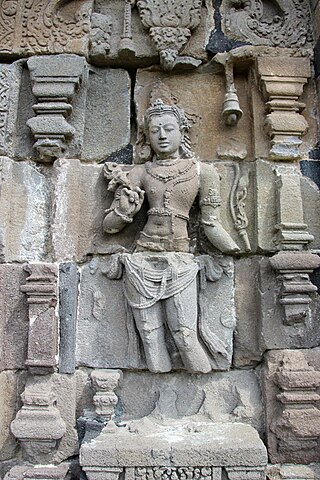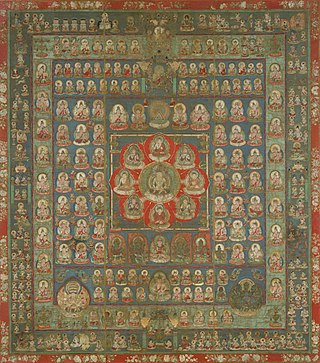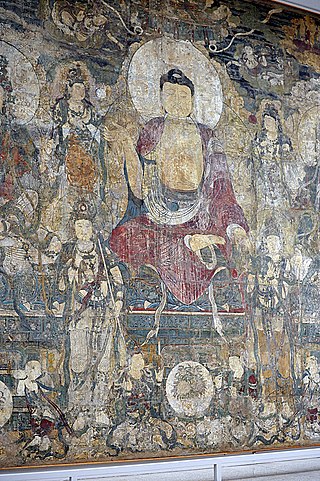
In Buddhism, a bodhisattva or bodhisatva is a person who is on the path towards bodhi ('awakening') or Buddhahood.

Shingon is one of the major schools of Buddhism in Japan and one of the few surviving Vajrayana lineages in East Asian Buddhism. It is sometimes also called Japanese Esoteric Buddhism, or Eastern Esotericism. The word shingon is the Japanese reading of the Chinese word 真言, which is the translation of the Sanskrit word mantra.

Buddhist symbolism is the use of symbols to represent certain aspects of the Buddha's Dharma (teaching). Early Buddhist symbols which remain important today include the Dharma wheel, the Indian lotus, the three jewels and the Bodhi tree.

In Vajrayana Buddhism, the Womb Realm is the metaphysical space inhabited by the Five Compassion Buddhas. The Womb Realm is based on the Mahavairocana Tantra. The name of the mandala derives from chapter 2 of the sutra, where it is said that the buddha Mahāvairocana revealed the mandala's secret teachings to his disciple Vajrasattva from his "womb of compassion". In other translations, the term Matrix Realm or Matrix Mandala is used.

Bhaiṣajyaguru, or Bhaishajyaguru, formally Bhaiṣajya-guru-vaiḍūrya-prabhā-rāja, is the Buddha of healing and medicine in Mahāyāna Buddhism. Commonly referred to as the "Medicine Buddha", he is described as a doctor who cures suffering using the medicine of his teachings.

Manjushri is a bodhisattva who represents prajñā of the Buddhas in Mahāyāna Buddhism. The name "Mañjuśrī" is a combination of Sanskrit word "mañju" and an honorific "śrī"; it can be literally translated as "Beautiful One with Glory" or "Beautiful One with Auspiciousness". Mañjuśrī is also known by the fuller name of Mañjuśrīkumārabhūta (मञ्जुश्रीकुमारभूत), literally "Mañjuśrī, Still a Youth" or, less literally, "Prince Mañjuśrī". Another name of Mañjuśrī is Mañjughoṣa.

Vajrapāṇi is one of the earliest-appearing bodhisattvas in Mahayana Buddhism. He is the protector and guide of Gautama Buddha and rose to symbolize the Buddha's power.

Buddhism includes a wide array of divine beings that are venerated in various ritual and popular contexts. Initially they included mainly Indian figures such as devas, asuras and yakshas, but later came to include other Asian spirits and local gods. They range from enlightened Buddhas to regional spirits adopted by Buddhists or practiced on the margins of the religion.

Tara, Ārya Tārā, also known as Jetsün Dölma, is an important figure in Buddhism, especially revered in Vajrayana Buddhism and Mahayana Buddhism. She appears as a female bodhisattva in Mahayana Buddhism. In the Tantric Buddhism, Tara is a female Buddha who is a consort of Amoghasidhi Buddha. Tārā is also known as a saviouress who hears the cries of beings in saṃsāra and saves them from worldly and spiritual danger.

Ākāśagarbha is a bodhisattva in Chinese, Japanese and Korean Buddhism who is associated with the great element (mahābhūta) of space (ākāśa).

Sūryaprabha is a bodhisattva whose specialty is sunlight and good health. Sūryaprabha is often seen with Candraprabha, as the two siblings serve Bhaiṣajyaguru. Statues of the two closely resemble each other and are commonly found together, sometimes flanking temple doors. They are also recognized in mainland Asia as devas.

The Japanese Buddhist pantheon designates the multitude of various Buddhas, Bodhisattvas and lesser deities and eminent religious masters in Buddhism. A Buddhist Pantheon exists to a certain extent in Mahāyāna. Still it is especially characteristic of Vajrayana Esoteric Buddhism, including Tibetan Buddhism and especially Japanese Shingon Buddhism, which formalized it to a great extent. In the ancient Japanese Buddhist pantheon, more than 3,000 Buddhas or deities have been counted, although now most temples focus on one Buddha and a few Bodhisattvas.

Mahamayuri, or Mahāmāyūrī Vidyārājñī is a bodhisattva and female Wisdom King in Mahayana and Vajrayana Buddhism. In the latter tradition, Mahamayuri is a popular practice in both the Chinese and Japanese forms of Vajrayana. She is also the name of one of the five protective goddesses in Buddhism.

The Buddha Tooth Relic Temple and Museum is a Buddhist temple and museum complex located in the Chinatown district of Singapore. The temple's monastics and devotees officially practice Chinese Buddhism.

Bhaiṣajyarāja, or Medicine King, is a bodhisattva mentioned within the Lotus Sutra and the Bhaiṣajyarāja-bhaiṣajyasamudgata-sūtra. In chapter 23 of the Lotus Sutra, the Buddha tells the story of the 'Medicine King' Bodhisattva, who, in a previous life, burnt his body as a supreme offering to a Buddha. He is said to have been reborn over a period of numerous lifetimes healing and curing diseases, and is a representation of the healing power of the Buddha.

Paradise of Bhaisajyaguru (薬師佛) or Pure Land of Bhaisajyaguru is a painting created during China's Yuan dynasty. This painting was originally housed in Guangsheng Lower Monastery, Zhaocheng County, Shanxi. The painting, which was at the eastern gable wall of the Main Hall of the monastery, was purchased by Arthur M. Sackler and later was given to Metropolitan Museum of Art, New York, United States in 1954.

Cintāmaṇicakra is a bodhisattva and a manifestation of Avalokiteśvara. He is counted as one of six different forms of the bodhisattva that represent salvation afforded to beings among the six realms of saṃsāra. Among these incarnations, Cintāmaṇicakra is believed to save those in the deva realm.
The Eighty-eight Buddhas Great Repentance Text is a Buddhist text widely used in the repentance practice or ritual of Buddhism, especially in the East Asian Mahayana tradition, where it is recited daily in monasteries, temples, and households.
The Hall of Bhaisajyaguru is the hall to enshrine Bhaisajyaguru, who is also named "Yaoshifo" for short in Chinese Buddhism.



















